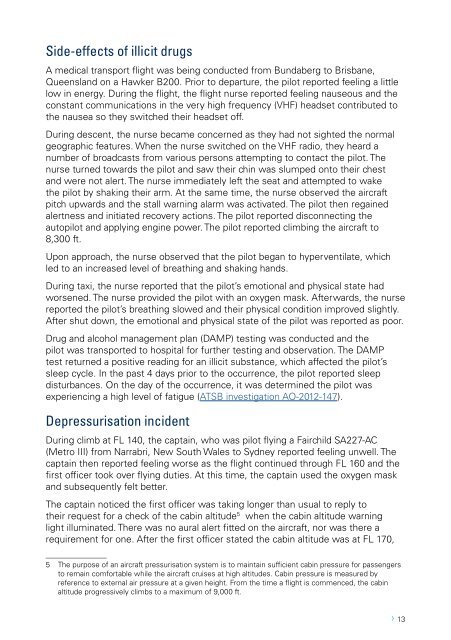Pilot incapacitation occurrences 2010–2014
8rKXy6YKY
8rKXy6YKY
Create successful ePaper yourself
Turn your PDF publications into a flip-book with our unique Google optimized e-Paper software.
Side-effects of illicit drugs<br />
A medical transport flight was being conducted from Bundaberg to Brisbane,<br />
Queensland on a Hawker B200. Prior to departure, the pilot reported feeling a little<br />
low in energy. During the flight, the flight nurse reported feeling nauseous and the<br />
constant communications in the very high frequency (VHF) headset contributed to<br />
the nausea so they switched their headset off.<br />
During descent, the nurse became concerned as they had not sighted the normal<br />
geographic features. When the nurse switched on the VHF radio, they heard a<br />
number of broadcasts from various persons attempting to contact the pilot. The<br />
nurse turned towards the pilot and saw their chin was slumped onto their chest<br />
and were not alert. The nurse immediately left the seat and attempted to wake<br />
the pilot by shaking their arm. At the same time, the nurse observed the aircraft<br />
pitch upwards and the stall warning alarm was activated. The pilot then regained<br />
alertness and initiated recovery actions. The pilot reported disconnecting the<br />
autopilot and applying engine power. The pilot reported climbing the aircraft to<br />
8,300 ft.<br />
Upon approach, the nurse observed that the pilot began to hyperventilate, which<br />
led to an increased level of breathing and shaking hands.<br />
During taxi, the nurse reported that the pilot’s emotional and physical state had<br />
worsened. The nurse provided the pilot with an oxygen mask. Afterwards, the nurse<br />
reported the pilot’s breathing slowed and their physical condition improved slightly.<br />
After shut down, the emotional and physical state of the pilot was reported as poor.<br />
Drug and alcohol management plan (DAMP) testing was conducted and the<br />
pilot was transported to hospital for further testing and observation. The DAMP<br />
test returned a positive reading for an illicit substance, which affected the pilot’s<br />
sleep cycle. In the past 4 days prior to the occurrence, the pilot reported sleep<br />
disturbances. On the day of the occurrence, it was determined the pilot was<br />
experiencing a high level of fatigue (ATSB investigation AO-2012-147).<br />
Depressurisation incident<br />
During climb at FL 140, the captain, who was pilot flying a Fairchild SA227-AC<br />
(Metro III) from Narrabri, New South Wales to Sydney reported feeling unwell. The<br />
captain then reported feeling worse as the flight continued through FL 160 and the<br />
first officer took over flying duties. At this time, the captain used the oxygen mask<br />
and subsequently felt better.<br />
The captain noticed the first officer was taking longer than usual to reply to<br />
their request for a check of the cabin altitude 5 when the cabin altitude warning<br />
light illuminated. There was no aural alert fitted on the aircraft, nor was there a<br />
requirement for one. After the first officer stated the cabin altitude was at FL 170,<br />
5 The purpose of an aircraft pressurisation system is to maintain sufficient cabin pressure for passengers<br />
to remain comfortable while the aircraft cruises at high altitudes. Cabin pressure is measured by<br />
reference to external air pressure at a given height. From the time a flight is commenced, the cabin<br />
altitude progressively climbs to a maximum of 9,000 ft.<br />
› 13


